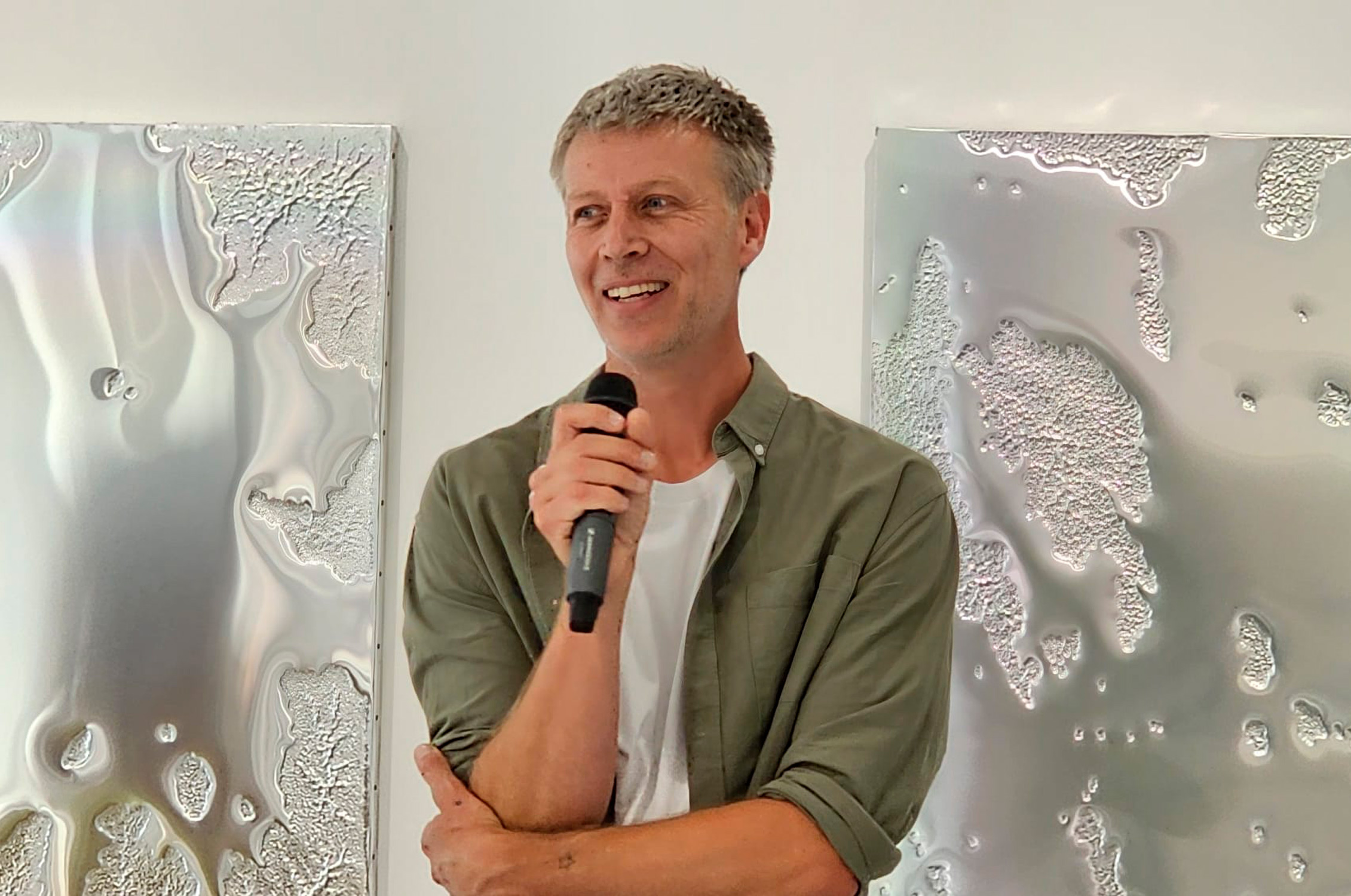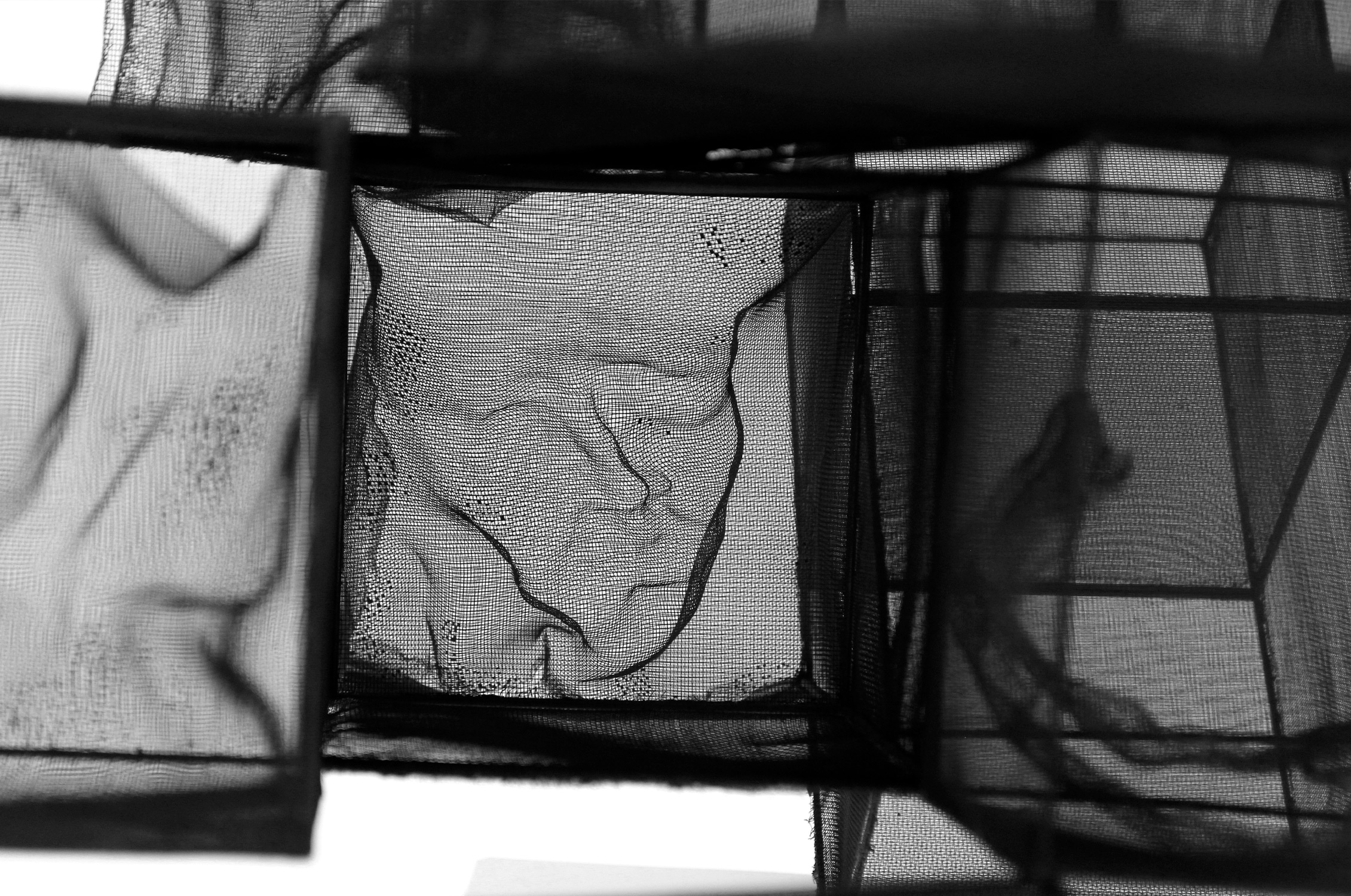COMEL AWARD 2024
Interview with Robert Hromec
by Ilaria Ferri
He was born in 1970 and graduated in Painting from Hunter College, New York (1998) and in Printmaking from City College of New York (1995). He studied fine arts at the Pratt Institute (1990-1991). He was awarded a scholarship to the Slade School of Fine Art in London, and in 2002, he received a BA in Art from the Slovak Technical University in Bratislava. In New York, he experimented with various techniques until he reached his own language, which he calls “printpainting.” His award-winning work has been shown in over seventy exhibitions in the United States, Canada and Europe. In the summer of 1997, one of his paintings was included in a group exhibition at the Metropolitan Museum of Art in New York. He lives and works in Bratislava.
In Rebirth IV, the winning work of the “Aluminum, Beneath the Surface” edition of the COMEL Award, you engraved, scratched, and painted on aluminum. What was it like working with this material? Had you experimented with it before? When did you realize it could be an excellent substitute for canvas and paper?
Falling Comet IV, 2019
The jury of the COMEL Award, in naming you the winner of the 11th edition, highlighted in their statement: “While the overall expressive framework recalls established registers of post-war informal art, the multifaceted and skillful intervention on aluminum represents an absolute, inspired innovation.” What artistic models and masters have most influenced and inspired you?
In my work I uncover the broader and deeper range of possibilities of processing the material in a more extensive range of reflections on passing of time, seeking the inner harmony and restlessness, intermingling of present and past. There are visible (mostly deliberate) references to the Renaissance painting, Baroque pomposity or American painting of the 1950s, as well as the inspiration by Frank Stella´s paintings, however, the outcome is a clearly distinguishable, strange disquieting work seeking its place in today´s world full of contradictions.
Using an aluminum plate as a base with its surface treatment adds depth to the painting, brings light inside, creates optical illusions and reflections, resembling another dimension and luminosity. The aluminum plate is sanded, scratched, drilled, polished, and stamped with various tools. Rough and gestural brushstrokes depict today’s chaotic world, contrasting with the outlined images of hands that represent harmony and peace, referring to the pursuit of unity between body and soul, typical of the art of Antiquity and the Renaissance.
The Rebirth cycle celebrates renewal. The explosion of colors, which has always been a hallmark of your work, is even more pronounced, as if a primordial magma of art could give rise to your new path. Can you tell us more about this?
It is my new vibrant journey of colors tied to a new opportunity to understand life. This moment of a new beginning is my “Rebirth,” expressed in a lively and often smiling way.
This vibrant new journey is the balm of life, emphasizing the importance of maintaining a happy state of mind to face difficult moments and overcome them. “Rebirth” moves fluidly between inside and outside, open and closed at the same time, curious and eager to embrace the complexity and variety of life, on all levels where it unfolds.
Rebirth II, 2023
Rebirth III, 2023
Throughout your artistic journey, the human figure has always been significant and present—not naturalistic but consistently stylized. In your most recent works, the Rebirth cycle, where hints of hands and eyes appear frequently, the figure seems even more fragmented. What does the human body represent for you, especially the parts you depict most often?
I enjoy constructing my images using a variety of techniques blended with printmaking. This layering and overlapping bring many surprises. Human figures are the focus of my work. I position them in interaction with each other, as well as within themselves and with the surrounding world. Through the exploration of texture and the human body, I seek to make visible a dynamic balance between the mundane and the otherworldly, represented by a continuity that encompasses the human being, the world, and the spirit. In my works on aluminum plates, one can find many distinct opposites both in terms of ideas and artistic means of expression: chaos ↔ harmony, beginning ↔ end, abstract painting ↔ realistic details of human body parts.
Allegria I, 2024
Looking at the pictorial cycles that have marked your career, there is a noticeable inner, spiritual search with nods to philosophy and myth—a storytelling and epic vein that accompanies the explosion of colors. Is art for you a tool to explore and understand the world around you, or a way to narrate your inner world?
My paintings are about the psychological, emotional and physical dynamics of people. The work is ultimately about my own interaction with the materials I utilizes and about the joy of process. My sources of inspiration run deep. I am not certain where to place myself within a certain lineage of art history – nodding to collage, assemblage figurative Expressionism, or vainly reaching to bring in the tone of Rilke or Kundera would help one to understand more fully my endeavor .This love of tangible is what allows me to approach my work with freshness and honesty, pushing forward. My care of the process is apparent in my work, which strives to capture, exalt express and make tangible the absolutely intangible essence of what it means to be human.
One of my favorite authors, Herman Hesse, in his premier work, The Glass Bead Game, wrote, “…from a certain standpoint ordinary people can more easily and less responsibly express in words things that do not exist rather than those which do, whereas for a saintly and conscientious writer it is completely the reverse: Nothing evades verbal expression more, and yet nothing is more necessary than to place before people’s eyes things whose existence is not provable nor probable, since because saintly and conscientious people deal with them as if they did exist, they bring them one step closer to being, and to the possibility of their birth.”
“Art teaches nothing except the significance of life.” Henry Miller
Your education and career have been cosmopolitan. How has traveling influenced your approach to art? What have you taken from each country you’ve visited, and how have you poured it into your work? In particular, since you’ve frequently exhibited here, what is your relationship with Italy and its culture?
Over time, I have refined my artistic language, influenced by the countries I have visited. As a student, I spent more than eight years attending university in New York, worked at the Metropolitan Museum of Art, and spent several months in London. As an artist, I have exhibited my paintings in many countries around the world. All this has certainly left a mark on my art.
In New York my studio nested in the center of New York City, with Times Square seen from the windows. By viewing a large amount of my works there at once, standing amidst those in process, and seeing the objects I collected created a tension with quite different energy of the life just outside my studio. Even though many of materials I used in my paintings were from New York, there was a quality I brought to my work that was carried across an ocean, something ancient, linked to a long lineage. It was precisely the quality of my craft, the time involved in its process, the painted layers and repeated imagery in my work which made me think of the residues of history. As an artist, I have always had a special fondness for Italy. I first came to Italy almost 37 years ago with my parents by car. I was sixteen years old, and we traveled to Florence, Bologna, Venice… We crossed half of Italy. The most important reason why I love Italy is the presence of history, art, the beauty that surrounds you, and the historic architecture found everywhere in Italy. In this beauty, life flows somewhat slowly, and I have always found this wonderful. From that moment on, I visited Italy often, and that same feeling is still there. These aspects make you feel so good that you soon return to breathe in its beauty deeply. It has become my way of life.









